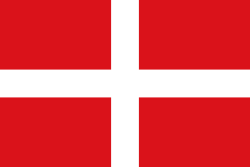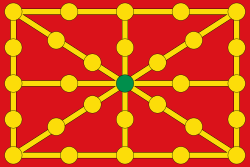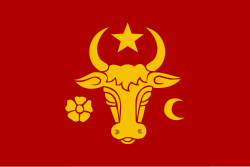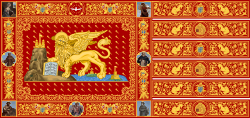Osmansko-uherské války
| Osmansko-uherské války | |||
|---|---|---|---|
| konflikt: Expanze Osmanské říše na Balkán | |||
 Obléhání Bělehradu (1456) – oběť Titusze Dugovicse, Alexander von Wagner | |||
| Trvání | 1366–1526[1] | ||
| Místo | Balkán, Uhry | ||
| Výsledek | osmanské vítězství, rozdělení Uher | ||
| Strany | |||
| Síla | |||
| |||
| Některá data mohou pocházet z datové položky. | |||
Osmansko-uherské války byla série válečných konfliktů mezi Osmanskou říší a Uherským královstvím s jeho evropskými spojenci. Po byzantské občanské válce, osmanském dobytí Galipole a bitvě na Kosově poli, Osmanská říše zahájila dobývání Balkánu. Nicméně Osmanský postup v Srbsku vedl Uhersko k válce proti Osmanské říši.
Počáteční uherský postup kulminoval v křížové výpravě k Varně, i když bez vnější podpory byla uherská vojska poražena. Přesto byli Osmani poraženi u Bělehradu, poté co dobyli Konstantinopol. Osmanský postup byl zastaven v Moldávii díky uherskému zásahu, ale Osmani nakonec dosáhli triumfu, když padla Moldávie i Bělehrad. V roce 1526 Osmani porazili uherská vojska v bitvě u Moháče vedená králem Ludvíkem Jagelonským, jenž zahynul spolu s 14 tisíci pěších. Důsledkem této porážky propukla v Uhrách občanská válka a Uhry byly nuceny platit Osmanům tribut. Uhry se v této době rozdělily na tři části: Horní (královské) Uhry, Sedmihradsko a Budínský pašalik.
Související články
- Osmansko-habsburské války
- Expanze Osmanské říše na Balkán
- Budínský pašalik
Externí odkazy
 Obrázky, zvuky či videa k tématu Osmansko-uherské války na Wikimedia Commons
Obrázky, zvuky či videa k tématu Osmansko-uherské války na Wikimedia Commons
Reference
V tomto článku byl použit překlad textu z článku Ottoman–Hungarian Wars na anglické Wikipedii.
- ↑ Království zaniklo de facto jako svrchovaný stát po bitvě u Moháče Habsburkové se stali vládci zbytku Uher
Média použitá na této stránce
Banner of Kingdom of Poland in the 14th century
A seal of Duke Premislaus II from 1290 shows the ruler holding a banner emblazoned with a crowned eagle. During the reign of King Ladislaus (r. 1320–1333), the red cloth with the White Eagle was established as the royal banner. The orientation of the eagle on the banner varied; its head could point either upwards or towards the hoist.
Autor: David Liuzzo, eagle by N3MO, Licence: CC BY-SA 3.0
Banner of the Holy Roman Empire, double headed eagle with halos (1400-1806)
Autor: Oren neu dag (talk), Licence: CC BY-SA 3.0
Royal flag of France before the Revolution (heraldic banner of "France modern")
Flag of the State of the Teutonic Order
Vatican flag before1808
Při zobrazení tohoto souboru lze snadno přidat orámování
Autor: BlinxTheKitty, Licence: CC BY-SA 4.0
Possible flag or banner of the Ottoman Empire (or Ottoman army) according to Hieronymus (aka Jérôme) Bosch (crwflags.com), the painter lived in the Middle Ages (c. 1450–1516) in Brabant and some of his paintings show Ottoman flags. These are generally red with a white crescent. It was the end of the XVth century, when the Ottomans had just conquered Constantinople and thus ended the Byzantine Empire, that was a shock for the Christian world.
Autor: Oren neu dag (talk), Licence: CC BY-SA 3.0
Royal flag of France before the Revolution (heraldic banner of "France modern")
Autor: Samhanin, Licence: CC0
Flag of the Second Bulgarian Empire (Ivan Shishman of Bulgaria Era, 1380). as shown in the Guillem Soler.
Autor: Santasa99, Licence: CC BY-SA 4.0
Bosnian Royal Flag of Tvrtko I of Bosnia
Autor: Heralder, Licence: CC BY-SA 3.0
Royal Standard of the Crown of Castile (15th Century Style)
Autor: Tento vektorový obrázek byl vytvořen programem Inkscape od v ., Licence: CC BY-SA 3.0
Royal Banner of the Kingdom and Crown of Aragón
Autor: Dekodrak, Licence: CC BY-SA 4.0
Flag of Wallachia during the reign of Vlad Vintilă de la Slatina (1532-1535).
Autor: Ultimete, Licence: CC BY-SA 4.0
Flag of the w:Crimean Khanate during 15th century with the symbol of Giray Dynasty on blue background as shield flagtype according to the book "Kırım Hanlığı Tarihi Üzerine Araştırmalar" of Halil İnalcık.
Autor: Samhanin, Licence: CC0
Royal military banner of the Grand Duchy of Lithuania with the Double Cross of the Jagiellonian dynasty on the shield of horse rider.
Autor: Miguillen, Licence: CC BY-SA 4.0
Bandera de Navarra (versión antigua)
Autor: Samhanin, Licence: CC BY 3.0
Flag of Croatia (Early 16th century–1526) per source, which is historically innacurate as such a flag or coat of arms was used only since 1527 when the Croatian nobility elected the Habsburg dynasty.
Autor: Old!!man1234561234, Licence: CC BY-SA 3.0
Flag of the Serbian Despotate, 1402-1459.
Contemporary reconstruction. Flag of Moldavia in the 15th-16th centuries. Made after: Seal of en:Alexandru cel Bun (1400-1432) from the National Museum of History of Romania. [1], Image:AlexandruCelBunSeal.png, Image:StefanCelMareSeal.png. The first information regarding the color of the Moldavian flag (including elements) comes from a book of documents published in Krakow in 1533: The grand flag had a red field on which was nicely painted with gold the coat of arms of Moldavia (banderim magnum sericeum, coloris rubri, in quo arma terrae Moldaviae pulhre auro depicta erant).
Flag of Genoa
Flag of the Comune di Bologna, Bologna, Italy
State Flag of the Savoyard States (late 16th - late 18th century).
Autor: Cplakidas, Licence: CC BY-SA 3.0
The Byzantine imperial ensign (βασιλικόν φλάμουλον), as depicted in the 14th-century Castilian Book of All Kingdoms, and described in the Treatise on Offices by the mid 14th-century Byzantine writer Pseudo-Kodinos as being hoisted on imperial naval vessels. It features the tetragrammic cross with the four "B"s that is attested in contemporary portolans, on coins and reliefs.
Autor: Tento vektorový obrázek byl vytvořen programem Inkscape ., Licence: CC BY-SA 4.0
Official flag of the Republic of Venice used by the Doge Domenico Contarini.






























